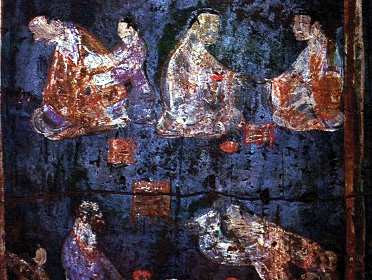Ancient China

Emergence of Ancient Chinese Civilization
The foundation of Ancient China is traditionally dated to 2100 BC. The emergence of Ancient Chinese civilization was greatly influenced by the introduction of irrigation. History of Ancient China is traditionally divided into three periods named after its ruling dynasties: Xia Dynasty, Shang Dynasty and Zhou (Chou) Dynasty. The period of Ancient China ended with unification of China by Qin Shi Huang in 221 BC starting the period of Imperial China which ended with the fall of the Qing Dynasty in 1912 AD.
Ancient China during Xia Dynasty
According to Chinese historian Sima Qian (145-90 BC) the first Chinese ruler was the legendary Yellow Emperor or Huang-di. The latter is one of the five mythological emperors before the Xia Dynasty which ruled Ancient China from about 2100 to 1600 BC. The Xia Dynasty was founded by Yu the Great who allegedly saved China by introducing the system of flood control. Jie, the last ruler of the Xia Dynasty was overthrown by Tang of Shang in 1600 BC starting the period of the Shang Dynasty.
Shang Dynasty and Oracle Bones
The Shang Dynasty is the first historically undisputed Chinese ruling dynasty. The most important sources for history of Ancient China under the Shang Dynasty (ca. 1600—1046 BC) are the oracle bones, pieces of bones or turtle shells which were used in divination. The economy during the Shang Dynasty based on agriculture and silk production. Archaeological finds also reveal outstanding bronze-works and jade carvings but the greatest achievement during the Shang Dynasty was the invention of writing.
Zhou Dynasty and Mandate of Heaven
Di Xin, the last ruler of the Shang Dynasty committed suicide after being decisively defeated in the Battle of Muye in 1046 BC. The Shang Dynasty was succeeded by the Zhou (Chou) Dynasty which ruled Ancient China from 1046 to 256 BC. Rulers of the Zhou Dynasty legitimized their rule by the Mandate of Heaven, a divine right to rule that was given and taken away by the heaven god Tian. This concept of divine right to rule was later adopted by the Chinese Emperors. The period of the Zhou Dynasty was also marked by development of a system similar to the medieval feudalism.
Decline of the Zhou Dynasty and Unification of China by Qui Shi Huang
The power of the Zhou rulers started to decline during the so-called Spring and Autumn Period or Chunqiu (771-476 BC) but this period is also known as the time of the greatest Chinese philosophers including Confucius, Laozi, Mozi and many others. Decline of the Zhou Dynasty continued during the Warring States Period or Zhangou (476-221 BC) when several states competed with each other for supremacy. In 221 BC, Qin under Qui Shi Huang defeated the other states starting the period of Imperial China. The rule of the Zhou Dynasty came to an end already in 256 BC when died the last Zhou king and neither of his sons proclaimed the nominal title King of China.




